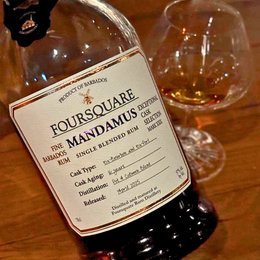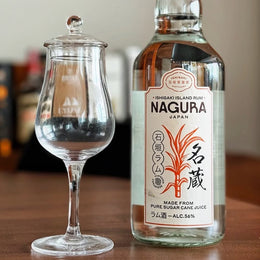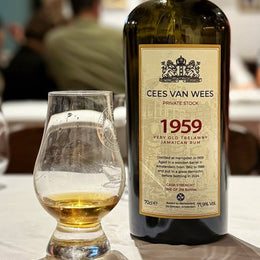
Hampden's are big - so when the Jamaican rum distillery releases a new mark, you'd be forgiven for being surprised that the interest in it would be pretty lukewarm.
Granted, there wasn't much fanfare, in fact it was all very quiet. No big marketing campaign; one has to wonder why that is. But Hampden's 9th mark is here - the "HES" which either stands for "Hampden Estate Sugars" or "Hampden Experimental Sugars", the former being stated on the official bottle's back label, while the latter is what Hampden's co-distributor La Maison du Whisky uses.
Either way, the unveil was really more of a random unannounced appearance at Whisky Live events around the world. It's particularly funny when you consider that when Hampden first released the now ubiquitous core 8 Year Old and Overproof expressions, the first aged official releases from the distillery itself, it came with what was called "the tasting of the century". How times have changed.


The core Hampden aged official releases were unveiled in an event that included a "tasting of the century" to mark the launch. How stark the difference today! (Image Source: Rum Diaries Blog)

Just take a look at what the core Hampden releases were put alongside, some of the most legendary rums, which really tells you what was thought of the two now-ubiquitous Hampdens when they were first released. (Image Source: Rum Diaries Blog)
In Singapore, this came in the form of a nondescript plastic bottle with a generic export label. This is the same bottle used for all other bottles whose official bottling had yet to make its way to Singapore.
As such, this was completed missed by many. Also this was placed at the VIP lounge rather than the general admission Hampden booth, which further limited how many palates got to sample it.
Either way, it's since been retailed on several popular online rum retailers, and is of course sold out (which isn't a high bar for Hampden). But thus far, still no marketing campaign. Which is fine, it wouldn't be something that ordinarily would stop the hoards from raving about it. After all, there's been no shortfall of releases that have been given the same treatment, but has still gone on to become the big talk of the town.

(Image Source: Spirit Academy)
So what gives? I suspect that the HES, a 3 year old that is quite uniquely made with brown sugar and dunder - a first for the Jamaican distillery, rather than the usual molasses and dunder which is the recipe for high ester classically funky Hampden rums, clocked in at a much lower ester count (253.5 gr/hlpa, which places it between the LFCH and LROK marks, on the lower end of Hampden's ester spectrum) than was unspokenly deemed satisfactory.
To be fair, could you expect more than the recent DOK mark which has an ester count that already sits on the Jamaican export limit (local regulations state that rums to be exported cannot exceed an ester count of 1,600 gr/hL AA)? But I suppose when you've given the people what they want and went the whole nine yards, anything else feels less than.

When you've opened the pandora's box, nothing else really excites the crowd anymore. (Image Source: Excellence Rhum)
That said, if you can put aside numerical comparisons, it's certainly a very interesting expression - the first time the Jamaican distillery has opted to use brown sugar rather than molasses. The hypothetical result of which should already inform anyone that the outcome was going to be a lighter style rum - which again, I suppose is the rationale for the lukewarm response. I've talked about how I personally don't like to use things like age or ester counts or even the popularity of a distillery as a gauge to deciding if I'm interested in something or if it is good - ultimately, these are all plot devices to the very simple test of whether you think it tastes good.
As such, when a fellow festival goer alerted me to it, I was very keen on trying this rum. I literally made a beeline in search for it. That the distillery presented a totally different production methodology was sufficient to pique my curiosity as to what it would taste like. After all, one of my favorite distilleries, Japan's Nine Leaves, uses brown sugar or kokuto, so if anything this was extra exciting - the promise being a completely different aroma and taste profile.

Hampden HES 2019, 60.5% ABV - Review
Color: Mahogany
Aroma: This is somehow distinctively Hampden, and also distinctively not Hampden - at the same time. The funky tropical fruits of bananas are present - awash in caramelised brown sugar, the glue-y acetone note is quite apparent as well. And yet, there's a note not so commonly associated with Hampden - black tea, herbal candy, Guilinggao (Tortoise Jelly), Pei Pa Koa ivy leaf and honey cough syrup.

There's also more on magnolias and other white florals, more on marzipan and fondant. Light olive brine reveals itself, alongside a fragrant woodiness reminiscent of lacquered agarwood - somewhat back in Hampden territory.
It's more mellow as compared to other Hampden expressions - more aromatic as well, but deeper, sweeter, and more rich - this is closer to Demerara territory than it is the usual funky Hampden profile.
Taste: Medium-bodied, this is lighter than usual, with more of an aromatic touch of white florals, vanilla cream and burnt caramel, Gula Melaka and pandan leaves (or Ondeh-Ondeh, a Southeast Asian confectionary made of the two). There's also nutmeg. The funky banana notes are present but take a distinct backseat to the sweeter more floral notes.

Texturally it's smooth, albeit as mentioned quite apparently lighter-bodied than what you might be used to with Hampden, yet on the other hand this is alot smoother than what we're used to as well. It goes down alot more easily and is much more accessible and easy on the palate.

Finish: There's a light but exceptionally aromatic herbal note of Pei Pa Koa cough syrup (ivy leaf and honey) and ginseng. The empty glass so distinctively reminds me of traditional Chinese medicine halls - a little musty and musky.
My Thoughts
While the Hampden DNA was still apparent on the nose, which by the way was quite complex and very aromatic and inviting, it was completely absent on the palate and finish, which was more reminiscent of a cross of Demerara rums and rhum agricoles - much sweeter, and more herbal and lighter bodied than usual molasses-based rums.
Frankly it's barely comparable to any Hampden's out there, and any comparison would either evoke disappointment (if you're a Hampden fan) or delight (if you don't enjoy Hampden's funk). As suspected, this was alot more reminiscent of Japan's Nine Leaves rum, albeit heavier-bodied and more intense.
My Rating |
😛Tongues out to all those who might've thought I might not have enjoyed it - spoiler alert! I really enjoyed it. Just forget for a moment it's Hampden. It's simple, easy drinking, thoroughly aromatic. One for those who haven't liked traditional Hampdens or like Demerara's and rhum agricoles. |
Is it terrible if I enjoyed it quite a lot? If you didn't tell me it was Hampden, I'd have thought it was probably rhum agricole, in which case this was a pretty enjoyable one, albeit not as complex as you might wish, it was still very enjoyable. It's simple, easy drinking and aromatic - anyone who dislikes it only does so because they came in expecting the classic Jamaican funk where there was none to be found.
Well, I enjoyed it. It's not quite Hampden, but it was very easy to drink. If you put aside the incredibly high bar Hampden comes with, you'll enjoy it too.
This is one for those who dislike traditional Hampdens, prefer Appleton, Demerara's or rhum agricoles.
Kanpai!

@111hotpot







